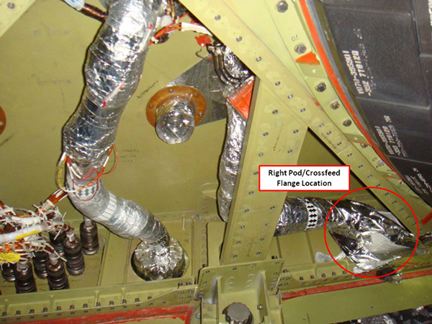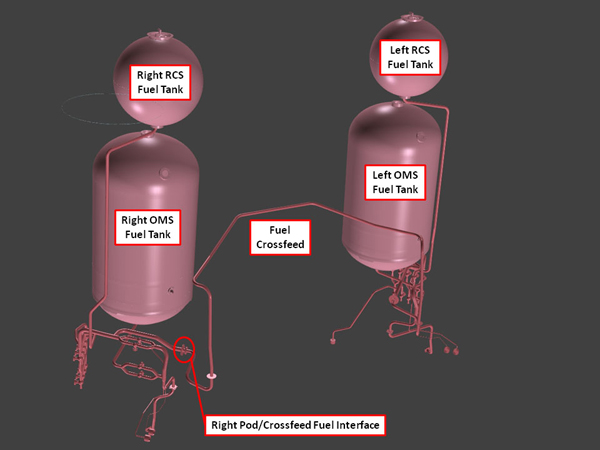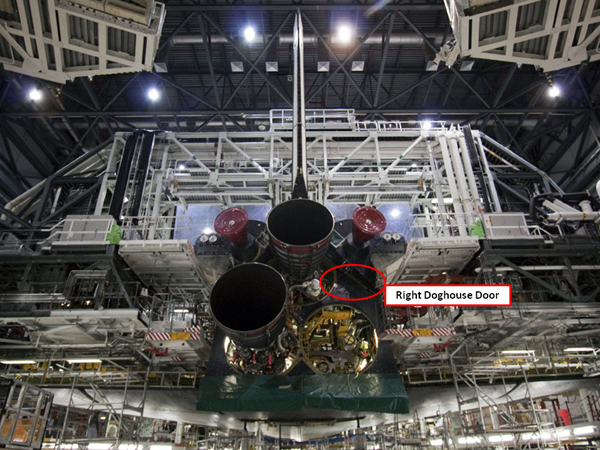NASA managers optimistic seal replacement will eliminate shuttle fuel leak
Editor's note...
By WILLIAM HARWOOD
CBS News
Engineers drained toxic rocket fuel from the shuttle Discovery's orbital maneuvering system rocket pods overnight Thursday, setting the stage for work to replace suspect seals in a fuel-line flange to fix an on-again off-again leak. Engineers say the schedule is tight, but they believe they can complete repairs in time for Discovery's planned Nov. 1 launch on a space station resupply mission.
"The tenet that we have is we fly with accepted risk, we don't fly with unknown risk," shuttle Program Manager John Shannon told reporters Thursday. "And I characterize this as an unknown risk case because we didn't understand why we had that small leak."
Discovery's countdown is scheduled to begin at 3 p.m. EDT (19:00 GMT) on Oct. 29, setting up a launch attempt at 4:40 p.m. (20:40 GMT) on Nov. 1. NASA managers plan to meet Monday for an executive-level flight readiness review.
Seepage of monomethyl hydrazine, or MMH, fuel was discovered last week at a crossfeed flange in the propellant plumbing of the shuttle's right-side orbital maneuvering system rocket pod.
The shuttle is equipped with two such rocket pods, one on either side of the ship's vertical tail fin, that burn monomethyl hydrazine with an oxidizer, nitrogen tetroxide, to carry out maneuvers in orbit. Crossfeed lines in the shuttle's aft engine compartment allow propellants to be moved from one pod to the other.
The leak stopped during inspections to make sure six flange bolts were properly tightened, possibly the result of increased pressure in the line causing an internal seal to properly seat.
But shuttle integration manager Mike Moses, uncomfortable with the on-again, off-again nature of the leak, decided to forego additional tests and inspections and ordered engineers to replace two internal seals to put the flange back in pristine condition.
Because of the toxic nature of the propellants, replacing the seals required launch pad personnel to clear the area during the fuel-draining process, interrupting normal processing. The off-loading procedure began at 9:25 p.m. Thursday and was completed at 5:30 a.m. Friday.
Once the lines are confirmed dry, technicians wearing bulky protective pressure suits will open up the flange, inspect the sealing surfaces, polish them if necessary, install new seals and put it back together.
"The team is working very hard right now to set up all the equipment to drain the tanks, they'll do what they call educting, basically take it down to (vacuum), get it all safe," Shannon said. "Then we'll be break that flange open and look at the metal sealing surfaces, look at the two sealing rings. They're like O-rings, metal covered with Teflon inside there. We'll understand the situation and I fully believe the team will get that back together this weekend and we'll be in good shape to go fly."
If the seal replacement does not resolve the problem, Discovery's launching almost certainly would be delayed.
"If there is some other problem or significant flange damage, or if we damage it somehow in trying to repair it, then we would lay that schedule out (for repairs)," Shannon said. "But we have not done that work yet."
- Posted at 01:26 PM, 10/21/10: Engineers prepare to offload rocket fuel for seal replacement.
- Updated at 07:30 AM, 10/22/10: Rocket fuel offloading operation complete.
 |
| Engineers are preparing to replace seals inside a fuel-line flange (circled) to fix a small leak in the shuttle Discovery's orbital maneuvering system plumbing. (Photo: NASA) |
By WILLIAM HARWOOD
CBS News
Engineers drained toxic rocket fuel from the shuttle Discovery's orbital maneuvering system rocket pods overnight Thursday, setting the stage for work to replace suspect seals in a fuel-line flange to fix an on-again off-again leak. Engineers say the schedule is tight, but they believe they can complete repairs in time for Discovery's planned Nov. 1 launch on a space station resupply mission.
"The tenet that we have is we fly with accepted risk, we don't fly with unknown risk," shuttle Program Manager John Shannon told reporters Thursday. "And I characterize this as an unknown risk case because we didn't understand why we had that small leak."
Discovery's countdown is scheduled to begin at 3 p.m. EDT (19:00 GMT) on Oct. 29, setting up a launch attempt at 4:40 p.m. (20:40 GMT) on Nov. 1. NASA managers plan to meet Monday for an executive-level flight readiness review.
Seepage of monomethyl hydrazine, or MMH, fuel was discovered last week at a crossfeed flange in the propellant plumbing of the shuttle's right-side orbital maneuvering system rocket pod.
The shuttle is equipped with two such rocket pods, one on either side of the ship's vertical tail fin, that burn monomethyl hydrazine with an oxidizer, nitrogen tetroxide, to carry out maneuvers in orbit. Crossfeed lines in the shuttle's aft engine compartment allow propellants to be moved from one pod to the other.
The leak stopped during inspections to make sure six flange bolts were properly tightened, possibly the result of increased pressure in the line causing an internal seal to properly seat.
But shuttle integration manager Mike Moses, uncomfortable with the on-again, off-again nature of the leak, decided to forego additional tests and inspections and ordered engineers to replace two internal seals to put the flange back in pristine condition.
Because of the toxic nature of the propellants, replacing the seals required launch pad personnel to clear the area during the fuel-draining process, interrupting normal processing. The off-loading procedure began at 9:25 p.m. Thursday and was completed at 5:30 a.m. Friday.
Once the lines are confirmed dry, technicians wearing bulky protective pressure suits will open up the flange, inspect the sealing surfaces, polish them if necessary, install new seals and put it back together.
"The team is working very hard right now to set up all the equipment to drain the tanks, they'll do what they call educting, basically take it down to (vacuum), get it all safe," Shannon said. "Then we'll be break that flange open and look at the metal sealing surfaces, look at the two sealing rings. They're like O-rings, metal covered with Teflon inside there. We'll understand the situation and I fully believe the team will get that back together this weekend and we'll be in good shape to go fly."
 |
| A diagram showing the shuttle's orbital maneuvering system propellant plumbing and location of leaking flange (circled). (Graphic: NASA) |
 |
| Engineers will access the flange worksite through a so-called "doghouse door" in the shuttle Discovery's engine compartment. (Photo: NASA) |
If the seal replacement does not resolve the problem, Discovery's launching almost certainly would be delayed.
"If there is some other problem or significant flange damage, or if we damage it somehow in trying to repair it, then we would lay that schedule out (for repairs)," Shannon said. "But we have not done that work yet."